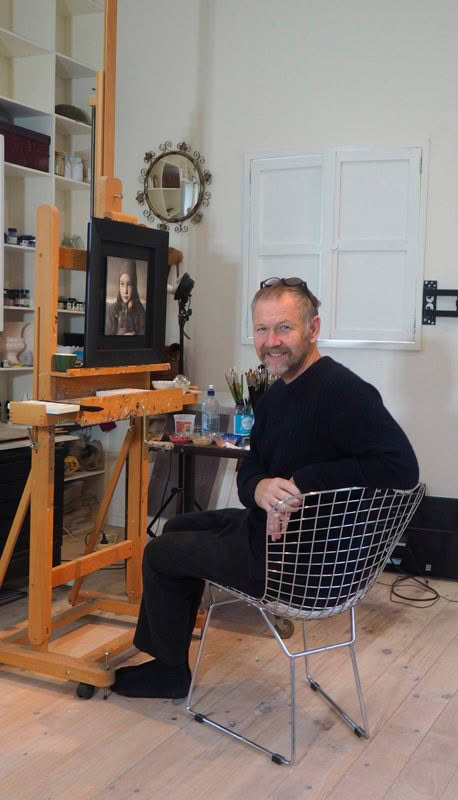Best seat with Simon Richardson

Words Claire Finlayson
When Dunedin artist Simon Richardson starts talking about his best seat – a sleek chrome wire affair – it seems like he’s misunderstood the brief. Damning it with the sort of faint praise one might lob at a worst seat, he says, ‘It’s not bad. It’s not too flashy. It’s semi-uncomfortable and quite hard. At least it’s solid – that’s one good thing about it.’
It turns out that a certain level of discomfort is a desirable trait in a painting pozzy. ‘If you’re going to be sitting for long periods of time painting, you don’t want it to be too comfy,’ Simon explains. ‘It’s like running shoes – the ones that are apparently the best are the ones with the least support because you have to develop all that strength yourself.’
The chair’s lack of indulgent cushioning cleverly thwarts any sedentary creep. ‘I get quite sore around my legs and bum after a while on the chrome wire netting – which is useful because it reminds me to stand up and look at my painting from a distance.’
Simon’s past is littered with the discarded bodies of unsatisfactory seats. In Goldilocks-esque fashion, he auditioned several seats before finding one that was just right. His first was a rather dull ergonomic chair. It was too ugly. ‘I had it for about a year and I hated it. You don’t just want an office chair – you feel like you want to have something that says you’re a serious artist.’
His second chair was much cooler, but he broke it. ‘It was one of those plastic replica Eames rocker chairs. I got it from Kmart and it looked amazing, but it basically split and halved itself while I was sitting on it.’
He replaced his ‘Eames’ with a rustic bentwood chair. That broke too. This sustained structural betrayal led Simon to stalk a more robust chair on Hayward’s Auction House’s online catalogue. It was there that he found 10 dollars’ worth of sturdy seating.
‘I also bought it because it looked semi-Scandinavian at a cheapish price. It’s quite hard to get a really good mid-century chair now because they’re so popular, and I didn’t really want to spend hundreds of dollars on it.’
His instincts were spot-on. The chair is actually a dead ringer for an iconic mid-century chair designed in the 1950s by an Italian-born American artist, sculptor and furniture designer called Harry Bertoia. Not that Simon knew this at the time of purchase.
When he learns the design pedigree of his cheapie replica during the course of this Best Seat interview, his furniture ardour increases exponentially. ‘Oh wow. That’s great. I feel much better about my chair now.’ When he discovers that similar Bertoia knockoffs sometimes fetch over $2,000, he’s even more chair-chuffed.
Most people wouldn’t choose a work seat as their favourite, but Simon’s job also happens to be his ruling passion. He paints from a studio on the Otago Peninsula which sits below the home he shares with his wife Gepke and children, Mila and Eben. He’s been a full-time artist for nearly three decades now and still thrills to it. ‘When I’m upstairs in the house relaxing, I’m always thinking about how much I can’t wait to do some more painting. I really do love my work.’
Most recently, Simon was one of 57 finalists (from 1,000 entries) in the coveted Archibald Prize portraiture competition with a work titled Portrait of Fiona Pardington (pictured below). This makes him one of only 10 New Zealand artists to have made it through to the final selection in the Australia-based competition’s 103-year history.
Part of the appeal of Simon’s work is its exquisite detail and old-world sensibility. He was once described by arts reviewer James Dignan as ‘a 17th-century Dutch master who somehow managed to be born in late-20th-century Dunedin’.
Simon is a big fan of egg tempera – a type of paint that has to be freshly prepared each morning with powdered pigment, water and fresh egg yolk. ‘I’m pretty good now but I used to waste a lot of eggs – they’d escape down the sink.’
It’s a medium that rewards small, careful, layered brushstrokes – which means Simon’s painting method is more tortoise than hare. ‘I’d be lucky to do five paintings in a year.’
Now that his chair has retrospectively acquired a classy Bertoia air, Simon may well hasten to his studio a little earlier in the day, egg perfectly separated and tempera ready. Might this increase the Richardson work rate? He reckons it could indeed ramp up production. ‘I might be able to do one painting every two months.’

